Sefa Utaki
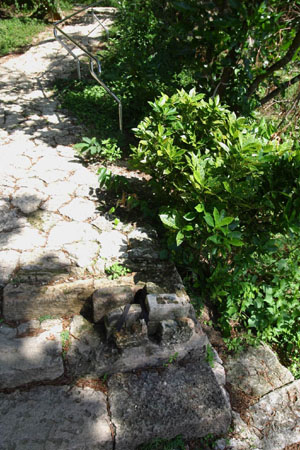 Sefa Utaki is a sacred grove located in the Kudeken area of Chinen Village. Pushing your way through the initial part of the path to the Utaki brings you to a spot where the path goes off to the left and intersects with the way to the first place of prayer, called "Uro-ka." Heading left leads to the Utaki entrance, the gate called "Ujouguchi." At one time common folk, especially males, were not permitted past this gate. It is said that originally the entrance passing to the Utaki was through the first place of prayer, the Uro-ka mentioned above.
Sefa Utaki is a sacred grove located in the Kudeken area of Chinen Village. Pushing your way through the initial part of the path to the Utaki brings you to a spot where the path goes off to the left and intersects with the way to the first place of prayer, called "Uro-ka." Heading left leads to the Utaki entrance, the gate called "Ujouguchi." At one time common folk, especially males, were not permitted past this gate. It is said that originally the entrance passing to the Utaki was through the first place of prayer, the Uro-ka mentioned above.
Farther in front of the gate, along the cobblestone path, there is an area called "Ufugui." The stone-enclosed courtyard is called "Una" and the place to offer prayer is in the rock shadows. This open area was the location where the kingdom's high priestess, the Kikoe Okimi, offered her first prayers in a ceremony called "Oaraori." This same name, Ufugui, is used for a place on the second floor of the main Seiden Hall in Shuri Castle, where the functions of the royal court were performed. On the day of the ceremony a small temporary booth is set up on the square stone floor. On the raised portion of the rock shadows, the high priestess, pillow in hand, retires with the gods for a short while.
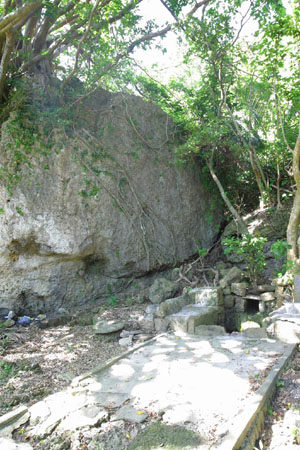 Deeper back into the Ufugui, the road splits to the left and right. Farther on to the left is Yuinchi, one more place of prayer. Yuinchi in this case means kitchen and, like Ufugui, this location is repeated in a corner of the Seiden Hall at Shuri Castle, an area referred to by the same name where the royal family's daily food was prepared. However, it has not been confirmed if the Yuinchi functioned as a real kitchen as is conveyed in folklore. Across the cobblestone path that passes through the stone enclosure is a large looming rock, and in the recesses of the place of prayer stalactites hang down off the rock.
Deeper back into the Ufugui, the road splits to the left and right. Farther on to the left is Yuinchi, one more place of prayer. Yuinchi in this case means kitchen and, like Ufugui, this location is repeated in a corner of the Seiden Hall at Shuri Castle, an area referred to by the same name where the royal family's daily food was prepared. However, it has not been confirmed if the Yuinchi functioned as a real kitchen as is conveyed in folklore. Across the cobblestone path that passes through the stone enclosure is a large looming rock, and in the recesses of the place of prayer stalactites hang down off the rock.
From Yuinchi, returning back along the path to the first split and taking the other path you will find two stalactites. The one in the immediate front is called "Amadayuru Ashikanubi" and the one on the other side is called "Shikiyodayuru Amaganubi." These names refer to the sacred water that falls from heaven. Below the stalactites is a vessel to collect the water. This water was utilized in a ceremony named "Unbinadi" by the Kikoe Okimi supreme priestess. It is said the amount of water that collects in the jar next to the stone indicates the prospects, rich or poor, for this year's harvest.
To the side of the two stalactites is a place to rest. Further from the platform is a large stone entrance that guides us on. Passing through this stone gate that is in the shape of an inverted 'V' leads to the Sangui, a place to offer prayers. This is a mere three-square meter space. On the right-hand side is the Chounohana, where prayers are sent to heaven through the stone wall. On
the left-hand side is a place to view and send prayers out to Kudaka Island.
The Origin of the Ruins
 As the most sacred site in the Ryukyus, Sefa Utaki has been passed down to us today. The origins of Sefa Utaki date back to the legendary time of the creation of the Ryukyus.
As the most sacred site in the Ryukyus, Sefa Utaki has been passed down to us today. The origins of Sefa Utaki date back to the legendary time of the creation of the Ryukyus.
"At the beginning of heaven, the great god of the sun shined beautifully. At the beginning of heaven the great god of the sun, the sacred sun, looked down from above. Gazing from enshrinement, the sun god commanded the creator goddess, Amamikiyo, and the male god, Shinerikiyo, to create the islands, the nations, the many islands, the many nations."
 By command of the sun god to the two gods, the islands and nations were created. Like in a ballad, this is the creation myth of the Ryukyus. The gods first made the sacred groves, the Utaki, in each region of the Ryukyus. One of those was Sefa Utaki.
By command of the sun god to the two gods, the islands and nations were created. Like in a ballad, this is the creation myth of the Ryukyus. The gods first made the sacred groves, the Utaki, in each region of the Ryukyus. One of those was Sefa Utaki.
The village of Chinen and its neighboring village, Tamagusuku, are locales deeply related to the gods of myths. They were later the location of important religious events of the royal court. Folklore has it that wheat and millet originated on Chinen Village's Kudaka Island and that rice cultivation was first carried out using the Ukinju Hainju waters from the Hamagawa River in Tamagusuku Village. Sefa Utaki and the adjacent regions are deeply related to the genesis of the Ryukyus, existing even today as sacred precincts.
After the Sanzan Kingdoms were unified and the royal court was established, the Chinen Tamagusuku region, even though divided, was the location of two important religious events of prayer, called the Ugariumai and Oaraori, centered in Sefa Utaki.
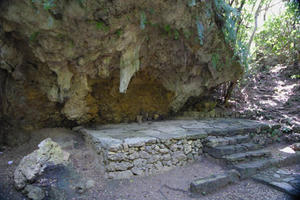 Since ancient times the regions we know as Chinen Village, Tamagusuku Village, Sashiki Town and Ozato Village and part of Yonabaru town were called Agariyu district and Agarikata and were intimately involved with the worship of the sun god. In the second month of the lunar calendar, when the ears of wheat come out, visits are made to Kudaka Island and when rice cultivation starts in the fourth month of the lunar calendar, the Utaki of Chinen and Tamagusuku are visited to pray for an abundance of staple grains. This is the basis of the Agariumai procession.
Since ancient times the regions we know as Chinen Village, Tamagusuku Village, Sashiki Town and Ozato Village and part of Yonabaru town were called Agariyu district and Agarikata and were intimately involved with the worship of the sun god. In the second month of the lunar calendar, when the ears of wheat come out, visits are made to Kudaka Island and when rice cultivation starts in the fourth month of the lunar calendar, the Utaki of Chinen and Tamagusuku are visited to pray for an abundance of staple grains. This is the basis of the Agariumai procession.
The Oaraori rites were assumption-of-duty ceremonies conducted for the supreme priestess, the Kikoe Ogimi, who served as head of the order of priestesses and lord of Chinen Magiri district. The position of Kikoe Ogimi was confirmed by Sho Shin, 3rd king of the Second Sho Dynasty, and was filled since that time. A queen or princess was appointed to the office of Kikoe Ogimi. The power of the Kikoe Ogimi, who presided over religious rites, was on a par with that of the king. Accordingly, the ceremony for Oaraori was unusually important and, at the same time, the lab or and costs related to the rites were large.
Episode at the Ruins
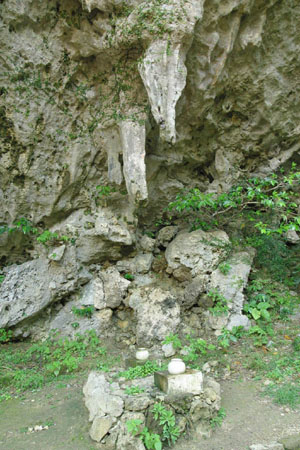 The performance of a procession of rites commanded by the king was of utmost importance since long ago.
The performance of a procession of rites commanded by the king was of utmost importance since long ago.
In particular, visits to the sacred groves of Kudaka Island, Chinen and Tamagusuku were where fertility rites and prayers for the stability of the nation were repeated. The biennial custom of processionals seeped deep as Samurai families, in making family trees, also made family processionals mimicking the Agariumai rites of the royal court.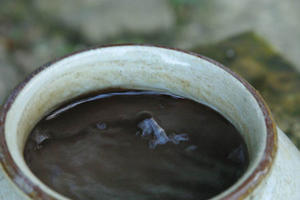 In 1879, after dissolution of the Ryukyu Kingdom, the class system was abolished and restrictions on agricultural villages and society removed.
In 1879, after dissolution of the Ryukyu Kingdom, the class system was abolished and restrictions on agricultural villages and society removed.
Taking this opportunity, people outside of samurai families took up the practice of the processionals. Inevitably, worship at Sefa Utaki was also freed and this custom has not been interrupted and is continued by the Okinawan people today.
In Okinawa, the people have relied on contacts with the gods and with connections to the power of the gods since ancient times. Drawing on this type of power was called "Sedzi" or "Shiji."
This type of spiritual power is believed to be more superior in women than men.
With Sedzi, the power is shown more in women than men and as it related to superiority, as is often seen in the relationships of sisters and brothers. This is the belief in what are called the "Onari gods." The important point in this belief is in the open-"Ekeri" -- energy of brothers and the "Onari"-- or conserving energy -- of sisters, which is the superior spiritual energy and that which protects the brothers and increases prosperity.
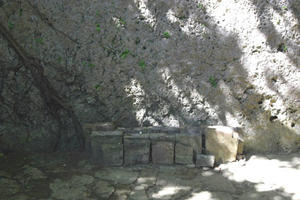 An example of this is the supreme priestess, the Kikoe Ogimi, often chosen from the king's sisters. From the start, beliefs associated with Utaki were centered on women.
An example of this is the supreme priestess, the Kikoe Ogimi, often chosen from the king's sisters. From the start, beliefs associated with Utaki were centered on women.
In the case of Sefa Utaki as well, the custom of women conducting rites is so thoroughly formalized and sacred that males were prohibited from entering inside.
Men were not permitted past a certain point at the Ujouguchi entrance. On occasions when males needed to enter to perform work in the mountains, they would stop at the entrance, untie their kimonos, and retie them to the left-hand side as women do. Today there is no such prohibition and people are free to come and pray.
Registry Point
(Shimajiri-gun, Chinen Village) Historic Site, Cultural and Scenic Spot
This area was one of the most prestigious sites in the Ryukyu Kingdom. The third ruler of the Second Sho Dynasty, King Sho Shin (ruled 1477-1526), established the organization to conduct state religious ceremonies. Seifa Utaki played an important role as a sacred grove where royal rituals and ceremonies were conducted to support the religious and spiritual aspects of the centralized monarchy. Seifa Utaki is an outstanding example of the expression of the distinctive way in which the Ryukyuans worship the natural environment. It is a designated historic sight.
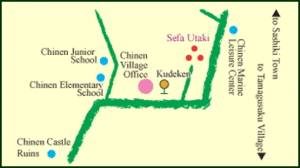 Management / Inquiries
Management / Inquiries
Chinen Village Board of Education Social Education Section
22 Kudeken, Chinen Village, Okinawa 901-1595 Japan
Phone: (098)948-1149
